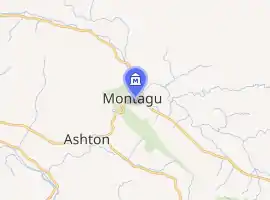Montagu Museum
The Montagu Museum, situated in Montagu, Western Cape, was built in 1907 and was declared a national monument in 1976.

| |
| Established | 1975 |
|---|---|
| Location | 41 Long Street, Montagu, 6720 |
| Coordinates | 33°47′20.48″S 20°7′15.14″E |
| Type | Cultural History |
| Curator | Nonkosi Mgijima |
| Owner | Department of Cultural Affairs & Sport (Western Cape Government), South Africa |
| Website | http://www.westerncape.gov.za/eng/directories/facilities/131/4616 |
Establishment of Montagu
Montagu was founded on the farm "Uitvlugt" in 1851, and is known for its hot mineral springs and scenic mountains.
Montagu is a town in the Western Cape province of South Africa, about 180 km from Cape Town in the western Klein Karoo. It is named after former secretary of the Cape Colony 1843-1853, John Montagu, but was once known as Agter Cogman’s Kloof, Cogman’s Kloof linking the town of Montagu with the railway station in Ashton which is known for the Langeberg Canning Factory.. He was a very able administrator and a man with vision who realized that the colony would not make significant progress without proper means of communication. Shortly after his appointment as colonial secretary he therefore initiated a road-building programme which left mark on the landscape, the economy and the social life of the colony. John Montagu was born in 1797- probably in India- where his father served in the British army. At the age of 17 he joined the army himself and served in the Battle of Waterloo in 1815. His military career blossomed and he married Jessy Worsely in 1823. Thereafter his career took a new turn when he entered the service of the colonial government of Van Diemensland (Tasmania). After serving two more years in the military (1829–31) he returned to Tasmania, occupying the post of colonial secretary from 1834 to 1842. In this senior post he gained valuable experience showing a gift for efficient administration. However after a clash with the lieutenant-governor he left Tasmania in 1842. Later in 1842 a report on his clash with the lieutenant governor exonerated him from any misconduct and he was offered the post of colonial secretary of the cape colony. He arrived at the Cape in April 1843. It is situated at the confluence of the Keisie and Kingna rivers.[1]
The Museum and its theme
The main aim of the Montagu Museum is to research and portray the cultural-historical heritage of Montagu and its people.
The Museum owns a collection of oil paintings and drawings by the famous South-African artist Francios Krige who lived and worked in Montagu. Included in the collection is one of his major works ‘’Begrafnis in die Karoo’’ (Burial in the Karoo) which he bequeathed to the Museum.
The Museum has its own oval date stamp which is an exact replica of the postmark which was first used in Montagu in 1858. The distinctive design to post offices in the Cape from 1853 onwards, were based on Liverpudlian, and American date stamps. All letters and postcards mailed at the Museum are stamped with this unique date stamp.
The T.O Honiball collection of cartoons and books is an important acquisition. This famous South-African cartoonist whose worked appeared in the Die Burger for many years, became a household name for his satirical and humorous depiction of animal characters which still captivate old and young alike.
Take a look at the Brink Brothers exhibition at the Museum. Between 1902 and 1985 the Brink Bros enterprises was of mayor economic significance to the town. They were general dealers who owned a hotel, a department store, a winery which produced an extensive range of exotic liqueurs and fortified wines; a canning factory which exported canned fruit and they also produced dried fruit for the export market.
The archive which houses all documents, photographs and Africana relating to the history of Montagu, is becoming an increasingly important research centre. The devastation caused by the flood of 25 January 1981 has been fully documented by the museum.
The Museum has been researching traditional herbal remedies since 1982 and these are for sale at the museum or can be ordered by post.
Montagu Museum comprises the following historical buildings in Long Street
Joubert House
It is situated in no 25 Long Street. A proclaimed national monument which was built in 1853 and is the oldest house in the town. After the devastating flood of January 1981 it was saved from demolition and restored to its former glory by the Board of Trustees. Today it functions as a House Museum that portrays the lifestyle of the rural Victorian era. At the back of Joubert House there is an Indigenous Medicinal Plant Garden.
Montagu Museum Art Gallery
In 2007 the new art gallery was established in a part of the KWV Building Cnr Kohler and Long Street. It is the most interesting and noteworthy example of commercial architecture in Montagu from the early 1930s. The art gallery was opened with an exciting exhibition of sculptures and works by Willie Bester, internationally recognized artist and born Montaguer. Montagu Museum Art Gallery house a permanent exhibition of work by Francois Krige. Regular exhibitions by other noted South African artist are held in the gallery.
Other educational activities and services
- Educational programmes for primary and secondary schools
- Outreach programmes to the youth and elderly
- Guided tours of the Museum
- Historical information to the public for assignments.
References
- Heydenrych, H. 2005. 30 Stories of Montagu and its people.
Literature
- Administrator of the Province of the Cape of Good Hope, No 134,1975.
- Cape Museums Ordinance No 8 of 1975.